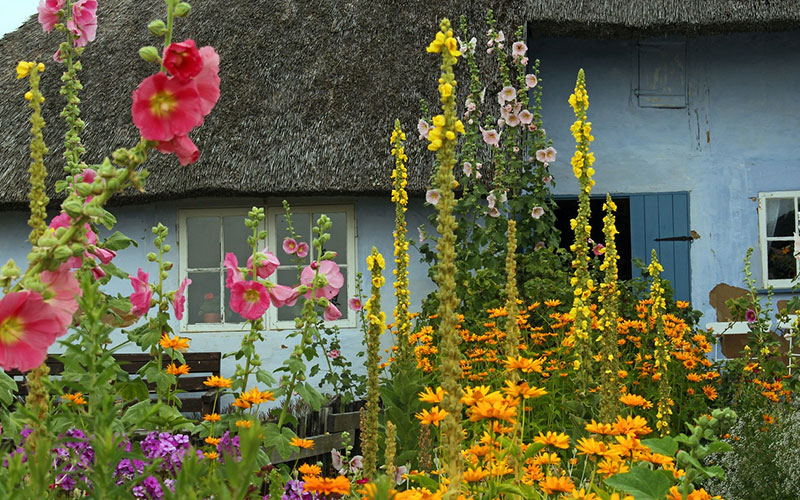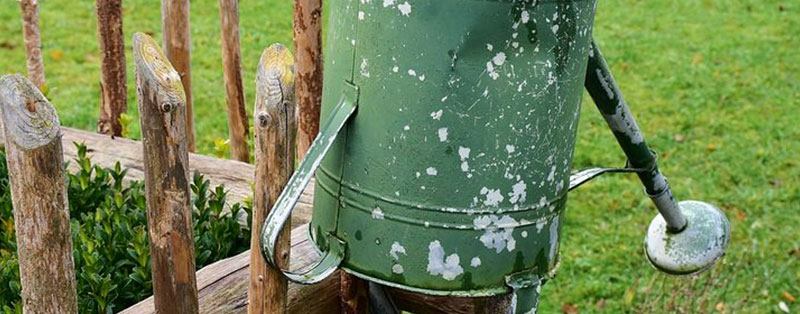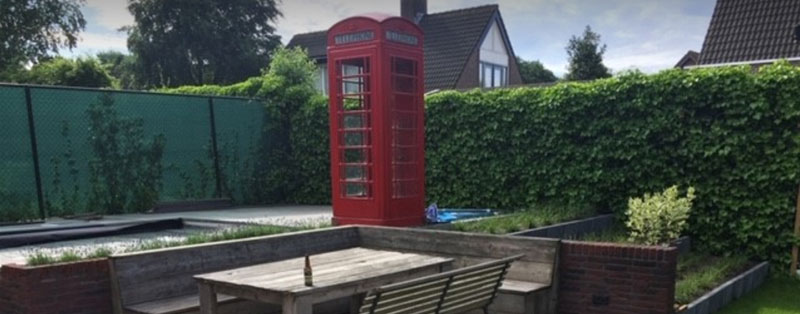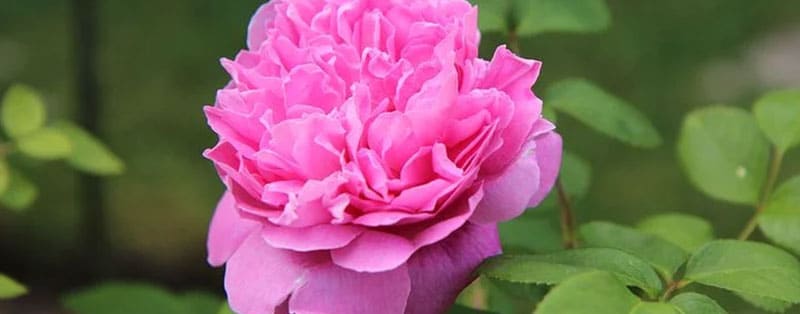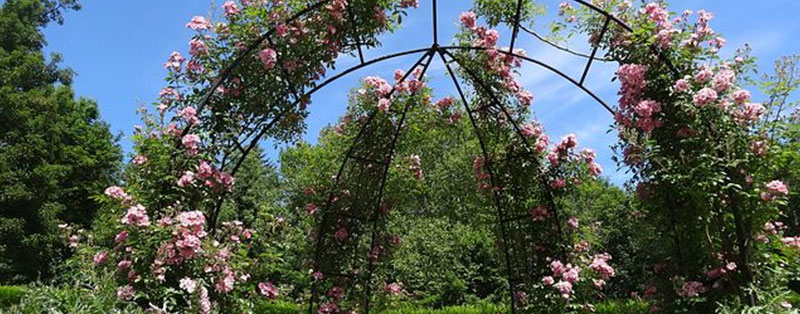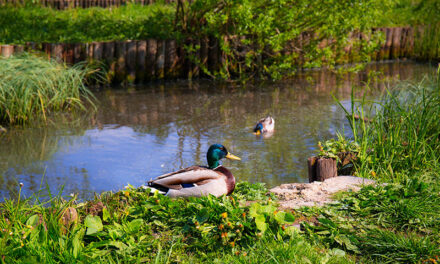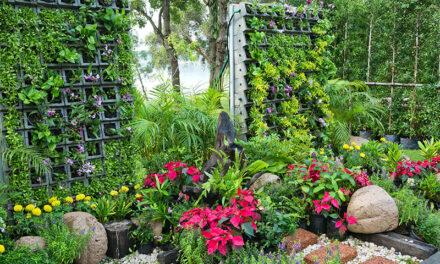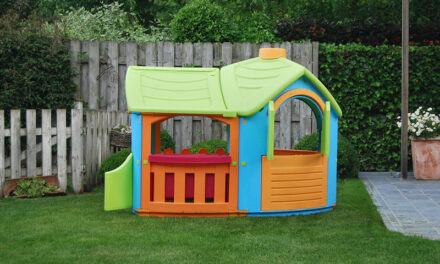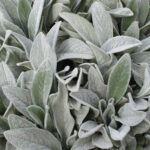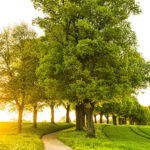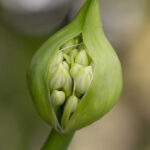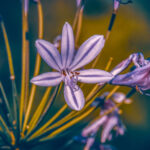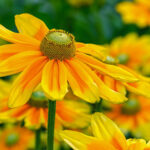An English Garden is a landscape garden, a garden without balance and symmetry. In contrast to the French Baroque gardens, you entirely abandon the idea that nature should be controlled by people.
The English garden is described as romantic park-like landscapes with surprising views. It is often landscaped with hilly lawns, grouped trees, and ponds. The English garden is described as a natural garden. But it’s often a well-thought-through design with a lot of artificial construction. The Vondelpark in Amsterdam is a good example of a natural English garden.
English garden style
The English garden can be divided into two types. The English landscape garden and the English cottage garden. The landscape garden is a park garden. The cottage garden is the English country garden. The last one is also suitable for smaller gardens. The similarity between the two is the informal shape and planting. You can give it a personal twist and use your favorite plants. There are no actual rules to an English cottage garden design, other than that it is not formal. So no symmetry, no clean lines, and no sculptures.
English landscape garden
Extensive lawns, preferably hilly, with grouped trees and landscaped “natural” ponds characterize the English landscape garden. You can enter the landscaped garden through narrow winding paths. I’ve never been to an actual English garden in England, but in Denmark I visited a beautiful English park: Liselund Park, on the island of Møn.
This is a romantic park with lawns, groves, very old trees, and lakes. The park is located close to the sea, from the park you have beautiful views. There was also a Norwegian Cottage and a Chinese Tea Pavilion. All characteristics of the English landscape garden. You can see the park in the following photos taken by myself.
English cottage garden
An English cottage garden is a garden with informal shapes. The plantation consists of a mix of perennials, ornamental grasses, roses, fruit trees, or shrubs. All across the garden, spots are filled with flowering plant species. It’s a perfect garden for plant lovers.
The ambiance is derived from the English country garden. You can find many flowering plants, flowers, scents, and shapes in it. The cottage garden is very suitable for reusing old materials such as stones and fences. All kinds of materials can suffice as planters or ornaments.
English garden design
Design
The typical English cottage garden often has the following elements: narrow paths, mysterious passageways or follies, small gates, small seating areas, lots of flowers and plants. A folly is a structure that is purposely useless or bizarre. It is a building that is not suitable for housing or other functions. Its sole purpose is decoration.
Flowers and plants that bloom for a long time are a starting point in English gardens. These are combined with early flowering bulbs. This gives you a very long period of flowering plants in the garden. Hedges that divide the garden into garden ‘rooms’ are regularly seen in the English garden, sometimes with differences in level. You can also create differences in level through the use of raised border edges with stacking stones, for example.
An English cottage garden also includes water, a pond, or an ornament with water. To be able to grow so many flowering plants, a greenhouse or garden cabinet is used. This can be ready-made or a self-assembled greenhouse. A greenhouse made of various recycled materials will certainly not look out of place. Using recycled materials, vintage or flea items in a different way with a personal touch certainly fits the English garden.
English garden decor
For a path or terrace use small stones or gravel, preferably split in earth tones. The tiles or gravel runs through the garden like a winding garden path. The path does not always need an end-goal. Just by having it end at a garden wall or chair with a cushion or as a view outside the garden, you visually enlarge the garden.
You can (re) use stacked stones playfully as a border or border edges. You can make the borders or planters as big or small as you have collected stones. The effect is extra spacious if you use different heights, the plants also look gorgeous in this. This way you can use lower plants above higher plants.
Place a cottage or greenhouse
When you have space, a Cottage is a perfect English object to finish your English garden. It could be a house that you can’t actually use, it does not have to be big in terms of space, but it must be there. A gazebo with a flowering climber or climbing rose also enhances the cozy feeling. Instead of a gazebo, you can place a pergola over a path. If you have sufficient space, you can plant flowers in a greenhouse in the spring, when it is still just too cold outside.
English gardens are bursting with color with all kinds of colorful blooming flowers and plants. I will elaborate on which flowers and plants you can consider later in this post.
Use all kinds of items, colored or not, such as flower pots, watering cans, buckets as decoration. You can also make lovely flower pots and planters from for example watering cans. Another indispensable decoration is small seats with colored cushions, they make your garden extra cozy. By using mirrors on the walls, surrounded by hedges or flowering climbing plants, you create fake views. The use of flowing, undulating, or still water makes a space larger, mainly due to the reflective effect of water. Water with a fountain creates movement which, if properly made, creates a spatial experience.
Wood in English garden
Another material that you can use in all kinds of ways is wood. You can use wood as a folly, like a cottage, as a seat, as a border, pergola, or a partition of space.
Old cabinets or cabinets that are no longer used can be used in the garden, as decoration, but of course also as planters. You can also place pots and containers on side tables. A table to work with your plants is also useful. If you can think of other typical English attributes, such as chandeliers, please just add them to your garden. I used an English telephone booth for a garden design with a client who often visits England for business. The red telephone box has been transformed into a garden shower by the pool. Wonderful idea! See the photo of the garden below.
English Garden plants
As I mentioned earlier, the English garden is a garden for enthusiasts. The structure of the English border is usually layered, a low row at the front, then a row of medium-high plants with a row of high plants at the back. The plants are often grouped together or as a wavy garland in groups of three, five, or seven pieces. The use of color is an important aspect of the border. In the English garden, you mainly find perennials and of course roses are essential. Many different flower shapes are used and often in the colors white, purple, and pink.
Trees in English cottage garden
You can use fruit trees, conifers, and deciduous trees together. Personally, I am a fan of multi-stem trees, I think they fit in any garden and therefore certainly in English gardens.
The Betula Utulis ‘Thornbos’ is a unique appearance, both on a stem and multi-stemmed variant. This tree also attracts butterflies and has therefore added value to the environment. It can grow up to 15 meters high and is not really suitable for small gardens.
Catalpa Bignoides Bungei is a compact bulb catalpa, which is also suitable for the smaller garden if properly pruned every year. This tree has a dense, rounded crown with dark green glossy leaves.
Tilia Palllida is the most famous and used espalier, and for good reason. This suitable Royal lime has a light green heart-shaped leaf, which can be placed on all soils.
The Oak, scientifically called Quercus, is a beautiful tree in many varieties. From evergreen to deciduous trees that are particularly suitable for the larger gardens and parks.
Malus, aka the ornamental apples, available in different sizes and colors are attractive trees for your garden. It blooms in spring with beautiful white, pink, or red blossom, after blooming the leaves start to grow. In autumn, small ornamental apples appear in the colors yellow, orange, and red. This way you can enjoy the ornamental apple tree every season.
Shrubs for the English border
Box hedges, or the comparable Ilex Crenata ‘Green’, give structure to the abundance of plants in your English garden.
Rhododendrons are evergreen shrubs, they bloom in white, pink, purple, red, and yellow. There are deciduous varieties, but generally, they are evergreen in winter. There are also dwarf varieties, tall Rhododendrons, and varieties suitable as a hedge plant. In a large English garden or park, you often see large groups of rhododendrons.
Azaleas belong to the Rhododendron family. They are a smaller variety with a rich flower and a smaller leaf. These look beautiful in your typical English border.
English Roses are the best known and perhaps the most iconic rose variety. The flowers are very recognizable. They have a strong scent and a well-filled flower. They were created by crossing the classic rose varieties with modern roses.
Perennials English border
Geraniums, Lady’s Mantle, Lavender, Catnip, Hydrangea, Creeping Thyme, Zeeuws Knoopje, Foxglove, Larkspur, Coneflower, Monarda, Yarrow, Ornamental Grasses, Celandine, Forget-me-nots, Primroses, Cuckoo flowers, so many perennials are suitable for the English border.
I’ll highlight a few, which are perhaps less known and in deserve an extra description.
Campanula is called the beautiful bell. The plant grows between 30 and 90 centimeters high. It blooms in June and July with sky blue or (the Alba variety) white bell-shaped flowers. They are particularly suitable for the partial shade border and can be combined well with columbines or daisies.
The Monarda “Gardenview Scarlet” is a striking appearance. It has a beautiful deep red flower, which attracts many butterflies. It flowers in July and August and can reach a height of between 70 and 100 centimeters.
Chelidonium majus or Stinking Celandine is a delicate yellow flower that resides in both shade and full sun. It is an elegant plant that grows to a height of 30 to 90 centimeters and flowers from May to October. You can enjoy it all summer long.
Climbers English garden
Climbing rose, I already mentioned the rose among the shrubs, but they are also available in climbing forms. The wisteria, for example, is known by its scientific name: Wisteria Sinensis, and has the same effect. This beautiful plant blooms in May and looks best if you let the plant grow over a pergola or something. The flower clusters can hang down freely, which gives a beautiful effect. Sometimes you have to be patient before the plant starts to flower. From my own experience, I know that it can take up to 7 years to bloom!
Honeysuckle is a climber that can be chosen in different colors, often multi-colored. Pink with white and yellow, orange/red, white with pink, yellow/orange, or just white are types of wild honeysuckle or Japanese honeysuckle. In the summer evenings, honeysuckle gives off a sweet scent that attracts and nourishes moths. The scientific name for Honeysuckle is Lonicera. This plant can be guided anywhere, past objects, or through other plants and shrubs.

